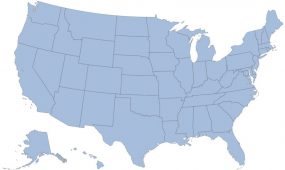State Licensing Scorecards
CDC’s State Licensing Scorecards assess how well a state’s child care licensing regulations support 47 high-impact obesity prevention standards. Scores are based on a state’s most recent licensing regulations and include four obesity prevention sub-domains:
- Healthy Infant feeding
- Nutrition
- Physical activity
- Screen time limits
In the last decade, many states have adopted licensing requirements that go beyond traditional health and safety rules to include health-promoting standards, such as infant brain development, emotional well-being, healthy eating, and physical activity. Learn more about State Childcare Licensing as a Tool to Support Obesity Prevention.
How are the scorecards used?
Each state’s licensing scorecard can help identify where center-based ECE regulations support high-impact obesity prevention practices, and where there is room to improve. The scorecards can be used several ways:
- Child care licensing officials and decision makers can plan and prioritize childhood obesity prevention efforts in their state. The scorecards provide detailed information on where ECE licensing regulations could be strengthened to more fully support healthy eating and physical activity policies and practices in licensed ECE programs. Decision makers can consult with their local public health department and healthcare professionals to learn about science-based recommendations for preventing obesity in ECE settings.
- ECE directors and teachers can ensure that they are meeting all of their state’s obesity-prevention licensing standards. They can see where they can put into action additional standards not required by their state’s licensing regulations to support the health of the children in their care.
- Parents and caregivers can learn about their state’s licensing regulations around infant feeding, nutrition, physical activity, and screen time in ECE programs. Parents and caregivers can discuss how these standards are being implemented with their child’s ECE providers.
State scores were calculated with a point-based algorithm developed by the CDC. Using annually published licensing ratings, an overall state score was determined by assessing how well licensing regulations for childcare centers support each of the 47 high-impact obesity prevention standards. More points were awarded when a state’s licensing regulations supported each of the high-impact obesity prevention standards, and fewer points were awarded when licensing regulations only partially addressed, did not address, or contradicted the obesity prevention standard.
Licensing Regulation Fully Supports Standard= 100 points
Licensing Regulation Partially Supports Standard= 70 points
Licensing Regulation Does Not Address Standard= 30 points
Licensing Regulation Contradicts Standard= 0 points
Each state scorecard contains two types of scores.
- Overall Licensing Scores. This is the summary score, representing how well a state’s center-based licensing regulations include the 47 high-impact obesity prevention standards. State partners can use this score to gauge how well their state supports obesity prevention in ECE regulations and compare themselves to others.
- State-Specific Sub-Domain Scores. To provide greater detail on where a state is doing well or may have room to improve, scores were calculated for each of the following sub-domains:
- Healthy Infant Feeding
- Breastfeeding support (1 standard)
- Infant feeding practices (10 standards)
- Nutrition
- Nutrition standards (15 standards)
- Healthy mealtime practices (6 standards)
- Physical Activity (11 standards)
- Screen Time Limits (4 standards)
The University of Colorado College of Nursing collects, analyzes, and rates licensing regulations in all 50 states and District of Columbia. These ratings describe how well regulations for center and home-based childcare programs include nationally recognized obesity prevention standards.
Find the 2022 national report below, as well as state-specific profiles highlighting ratings by care type.
- 2022 National Report: Achieving a Healthy Weight [PDF-2.2MB]
- State Profiles on Licensing Regulations in Child Care Centers [PDF-1.5MB]
- State Profiles on Licensing Regulations in Large Family Child Care Homes [PDF-1.5MB]
- State Profiles on Licensing Regulations in Small Family Child Care Homes [PDF-1.5MB]
Learn more about the scoring algorithm. [PDF-243KB]

